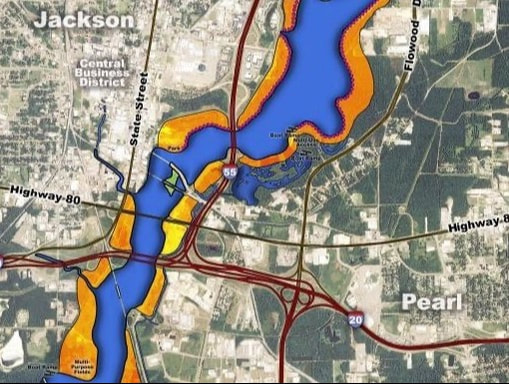|
In late July 2022, the Rankin-Hinds Pearl River Flood and Drainage Control District (Levee Board) transmitted their One Lake Environmental Impact Statement (EIS) document to the Office of the Assistant Secretary of the Army for Civil Works ((ASA(CW)) for the next step in the One Lake project review process. The ASA(CW) and the federal Office of Water Policy Review have 30-45 days to review the document before sending it to other state and federal agencies for another 30-45 day review period. If the document passes these 2 sequential review periods, the document will be published to the Federal Register and available for a 30-45 public comment period. It has not yet been determined if the document would be published as another Draft EIS or as a Final EIS. Public comment could begin as early as October 2022. The US Army Corps of Engineers Headquarters is responsible for preparing final recommendations and conditions based on the state and federal reviews. Many questions remain since the publication of the 2018 One Lake Draft Environmental Impact Statement (DEIS) including:
Pearl Riverkeeper will be looking for the answers to these questions and more upon the release of the next edition of the One Lake Environmental Impact Statement. **The Levee Board never publicly released the 2018 Independent External Peer Review or the 2018 US Army Corps of Engineers Agency Technical Review Summary Report. These 2 documents were obtained via FOIA request and can be viewed here: https://www.pearlriverkeeper.com/one-lake-agency-reviews.html
Jamie Grissom
9/8/2022 03:37:23 pm
The One Lake project just sounds like a disastrous idea.
Ryan Buchanan
9/8/2022 05:32:26 pm
I could not be more excited for this. I know the head engineer on this project that has worked over a decade on this. Our family land has been flooded for the past 20 years w jackson sewage up into our land and this is going to put a stop for it and help economic development for the city going forward
Pearl Riverkeeper
9/8/2022 07:46:58 pm
We appreciate your perspective. 9/9/2022 09:29:15 am
I think the COE should finish the Yazoo Pumps to control the backwater flooding before taking on another project in our state.
Jerry Touchstone
9/11/2022 10:28:36 am
I do not support this project. In recent days it has been proven that Jackson cannot manage anything. The Pearl River has become Jackson's toilet and the current flood gates only allows them to flush it their waste to communities on the lower end. As hard as we work to keep the lower Pearl River clean loads of garbage and waste filter down River. If you want to do something then reroute the Pearl River and cut Jackson out of the system.
Richard Carriere
9/13/2022 10:28:21 pm
A water filled lake is no more solution to flooding than filling a dry lake with concrete. The lakebed would mostly need to be kept near empty to provide some retention capacity in times of high river flow. The lake is more ruse than solution. I spoke with an operator at the Jackson Fewell water plant shortly after participating in a public One Lake information session in Slidell. There is a weir across the Pearl River just downstream of the Jackson Fewell water plant intake pipe The weir prevents polluted water that flows into the Pearl River just downstream of the weir from a stream that drains some portions of metropolitan Jackson including an electric generation station from soiling the intake water. The operator indicated it would be expensive to relocate the intake up steam if the flowing river became a lake as part of the One Lake vision. He also mentioned that no one at the plant had been contacted by the people promoting One Lake. Ironically the map showing the proposed project at the public gathering on One Lake highlighted the Jackson, Fewell water plant as being a sensitive location to leave undisturbed. Yet the operator I spoke with had been at the plant for many years and indicated that no one at the plant had been contacted regarding One Lake and how it might impair operations at the vital Jackson Fewell water plant.
Maggie King
10/14/2022 02:46:52 pm
I have lived in Bay St Louis, MS for 30 years and have been an advocate for protection, restoration and mitigation of the marshlands, the waters, the marine life and the humans who have lived in this natural beauty. Comments are closed.
|
AuthorPearl Riverkeeper is a licensed member of the Waterkeeper Alliance, the largest and fastest growing nonprofit solely focused on clean water. Archives
July 2024
Categories |
|
Ready to support our work for Clean Water and Healthy Rivers?
|
|


 RSS Feed
RSS Feed
